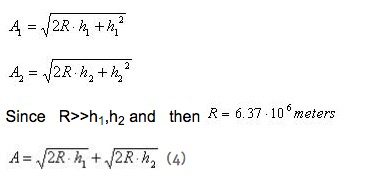Cellular Network Physical Range Limit
1.Introduction
Cellular network coverage is limited by several natural and physical factors, such as mountainous terrain, man-made obstacles or heavy foliage.
Cellular networks operators, when building or enhancing their network coverage over vast rural areas or long roads and highways, are looking for inexpensive means to meet their requirements.
The VEGA family of very high gain, narrow beam antennas can resolve many of these challenges in a most cost-effective way.
Although VEGA antennas, having extremely high gain over common Omni or Panel BTS antennas, can be a significant addition to the coverage design experts tool-box, they will not overcome some basic physical limits of radio signal propagation rules.
This technical note presents some of these range limitations, which should be considered when making the extended coverage design.
2.Very high gain antenna (VEGA) range extension limits
It is the physics of ground radio propagation that loss factor is not constant over the base station to mobile path.
There are two factors which affect the loss factor-
a. Environment type: The loss factors for various environment types are listed in Table 1 here in:

b. Range from the radiation source- the larger the range the higher the reflections, diffractions and dispersion.
It is therefore that for the faraway range, higher loss factors of 35 to 40 should be considered even where the environment is constant.
Close to the BTS the propagation losses follow the 20dB/Dec factor thus the propagation loss near the antenna is lower than the propagation loss at greater distance.
When intending to increase the effective range of a cellular base station by introducing a VEGA instead of another, lower gain antenna, the above table of rules should be considered.
Assuming that the path loss of a flat terrain from the BTS to its effective coverage range when using a certain antenna is L0, then the extended range to the farther effective limit contributed by VEGA is marked by d, as shown in Fig.1.

Fig.1 : Extended range of the VEGA over another antenna
The total propagation loss from BTS to the new range limit will be the sum (in dB) of the reference loss and the extended range edition:
The extended range is due to the higher gain of the VEGA, designated ∆G. The loss factor x will be set to 4 as explained previously. From Eq. (1) and the above reasoning, the following expressions evolve:
Or
Examples:
For ∆G=6dB, the extended range will be 41% larger.
For ∆G=11dB, the extended range will be 88% larger.
3. Base Station Radio Horizon
The Radio Horizon is defined as the maximum line-of-sight range assuming flat terrain, due to the earth curvature.
The common scenario of a BTS antenna installed high on a tower and the cellular users (in vehicle or pedestrian) with their mobile antenna located at ground level will be used. Meeting the above definition of Radio Horizon, a simplified model is shown in Fig.2. where: h1 and h2 represent the BTS antenna and mobile antenna heights above ground respectively and R is the earth radius .

Fig.2: Cellular BTS and Mobile Radio Horizon

Examples:
For BTS antenna height of 40m and mobile antenna at 1.5 meters above ground, the Radio Horizon will be 27Km.
For BTS antenna height of 100m and mobile antenna at 1.5 meters above ground, the Radio Horizon will be 40Km.
4.Delay and delay spread limits
The signal propagates between the BTS and the mobile via multiple different paths due to reflections, diffractions and scattering. This phenomenon is called Multi-Path Propagation.
The multiple paths have different propagation lengths and thus the accurate reception time of the different signals, varies.
The amount of this time variation is called Delay Spread. Usually the digital standard BTS and mobile receivers are equipped with an equalizer which can equalize the path delay differences up to a certain amount (up to 16µS or 4.5 Km for GSM).
It is obvious that the farther the mobile is from the BTS, the larger is the delay spread, especially in a hilly terrain.
Another limit on the cellular range is the propagation delay limit, inherent to every standard and BTS setting. For GSM, the mobiles are designed to have internal synchronization, called Timing Advance.
That feature will allow for propagation delays from very near-by signals to a maximum cell radius of 32Km, which is equivalent to 106µ propagation delay. The lack of synchronization ability will generally not allow cellular operation beyond these limits. The maximum delay compensation is set up in the BTS in 64 steps of 0.5Km each. The standard enables setting two timeslots for every subscriber and thus double the delay compensation to 72 km in the expense of cutting the capacity to half.
